Now & New
- Explore
Sera Tulip Hanameguri: April’s Next Most Popular Flower
When one uses the words “April” and “flowers” in the same sentence, what do you think comes to the minds of most people in Japan? I don’t know about you, but I know I speak for droves of people besides myself when I answer “cherry blossoms,” which are the Queen of Flowers in April all over Japan (with the exception of some Hokkaido and some parts of Tohoku, where they bloom in early May). In Hiroshima Prefecture, the sakura can bloom as early as late March, but they are almost always at their peak during the first few days of April before the next rainy day washes away the bulk of the flowers. After that, there is an array of April flowers that take the spotlight, including tulips, moss phlox, peonies, and more, but tulips without a doubt are the most anticipated flower after cherry blossoms. In fact, they are so loved that the first period of the Sera Hanameguri Kippu bus tour—which happens from early to mid-April—is centered around tulips, taking tourists to see them before any other garden.
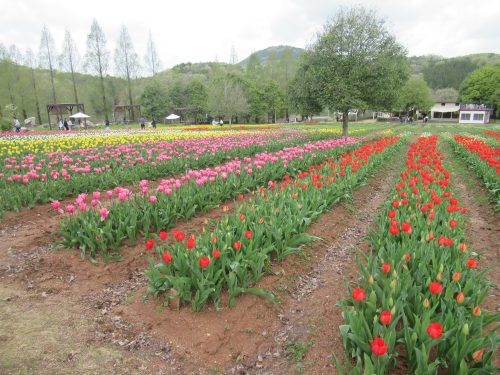
The Sera Hanameguri Kippu bus tour is something with which I was already familiar, as I had used the same service zipping around Sera to see sunflowers, pick blueberries, reach out to wisteria, and indulge in flower-covered soft serve ice cream. I have been visiting Sera once a year during the peak seasons of different flowers, and this expedition would mark my third time embarking via the Sera Hanameguri Kippu. Fortunately, the price of the bus ticket has been constant since I started going on these trips, at an affordable price of ¥4,500 per person, which includes a bus from the Hiroshima Bus Center to 甲山営業所 (こうさんえいぎょうしょ – Kosan Business Office), a shuttle bus that takes visitors to three different gardens around Sera as well as to Sera Winery and Roadside Station Sera, and a final bus from Roadside Station Sera back to the Hiroshima Bus Center. With five periods that the Sera Hanameguri Kippu bus tour is offered, one could theoretically go five times in one year and see different sights each time, but in order to not get flower burnout, I suggest instead going once a year, which means I would be stretching out my enjoyment of Sera over the course of five years!
世羅高原農場 (Sera Kogen Farm)
I knew the drill by now: we dismounted at the Kosan Business Office and received the customary rundown on how the Sera shuttle bus worked. We were given lanyards in which to insert our Sera Hanameguri Kippu tickets and flash like an ID when getting back on the shuttle bus, were told it was not a bus rented out just for us, blah blah blah…It was tempting for me to tune out the scripted standard operating procedure, but I knew that if I did, I might forget one of the crucial, albeit obvious, points of the tour. Before we knew it, our shuttle bus was here to pick us up and transport us to the first garden, Sera Kogen Farm, the reason most of us joined this tour to begin with.
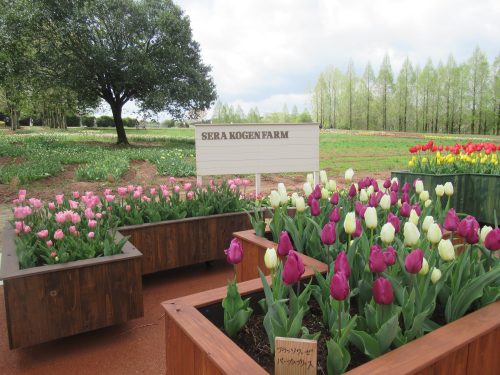
As soon as we entered the grounds, we were greeted by a painted wooden sign and some planters with tulips gracing us with their presence before we even had a chance to explore the fields. The names of specific cultivars were written on wooden planks in katakana and placed in the loam in front of the blooms. Tulips were definitely the main event, but they had other pretty flowers on display too, such as this planter of lotuses floating on water.

Tourists are also welcome to walk among the tulips themselves in the middle of the fields, but do exercise caution, as the earth beneath the flowers is wet, muddy, slippery, and stinky on account of all the water and fertilizer required to make the tulips thrive. I myself found myself getting my shoe stuck in the mud occasionally, almost falling over, and coming out of the fields with more gunk on my shoes than I care to write about. They had sinks here and there specifically designed for visitors to wash and scrub their footwear clean, but so many folks were using them that waiting in line meant less time to view flowers, so I continued, muddy sneakers and all.
In another corner of Sera Kogen Farm was a lookout point; I playfully jumped over a puddle and ran onto the wooden platform to peer out onto the fields below. The gardeners had made a mural of flowers (most likely tulips) that resembled tulips when viewed from a distance. Apparently, tourists were also allowed to walk down there and admire those fields up close, but I was feeling a bit lazy, and I had a shuttle bus to catch, so I cut my losses and left.
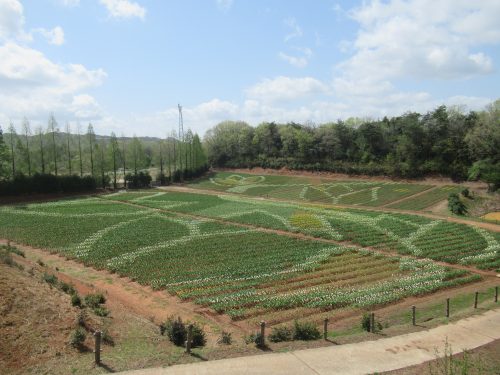
Speaking of getting close to tulips, visitors also have the option of paying to pick their own tulips from a field elsewhere to take home and care for. Those who are interested first tell the man under the information tent how many tulips they wish to pick, pay in advance, and then obtain a slab of wood for digging up flowers before receiving an explanation on how to properly remove the flowers from the soil. After plucking the tulips, the staff under the information tent meticulously wrap them in newspaper and put them in a plastic bag for safe, convenient transport until the blooms find their new home.
香山ラベンダーの丘 (Kozan Lavender Hill)
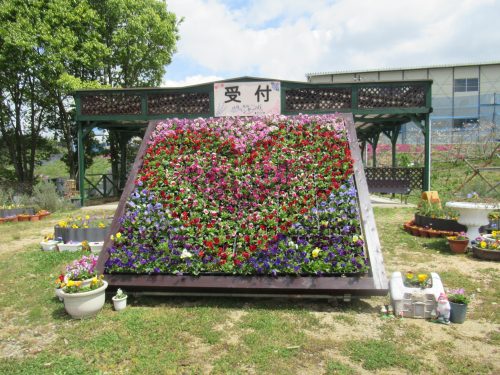
Without further ado, the shuttle bus took us to stop number two on the tour: Kozan Lavender Park, which on the 16th of April was far from hosting any lavenders. However, it was poppy season, which meant the fields here were still a spectrum of warm colors; red, orange, yellow, and white poppies littered the fields here, with abstract objects dotted about to create a particularly photogenic landscape. I especially liked how one of the first things I saw was a sign that properly welcomed me right before the first lookout point, as if beckoning me into a floral wonderland on a different plane of existence.
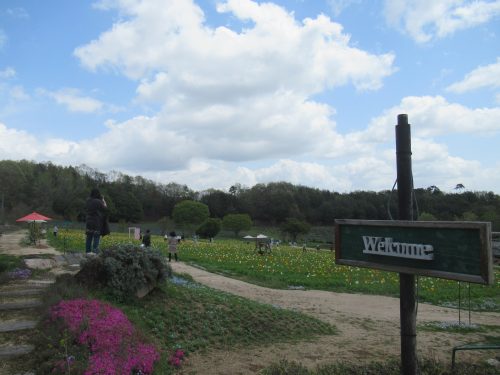
Have you ever been to an art museum featuring Impressionist or modern paintings of fields of flowers and thought, “I wonder what it’s like inside that painting,” with the desire to tackle the canvas? Well, wonder no more, because Kozan Lavender Hill helps answer that question with a swinging bench smack dab in the middle of the poppy field, a log collage wooden photo frame, and a pink door leading nowhere that might have dropped out of Doraemon’s pocket. The swinging bench was popular with couples and groups of friends, as it provided not only selfie opportunities, but also a break from strolling through the vast field.
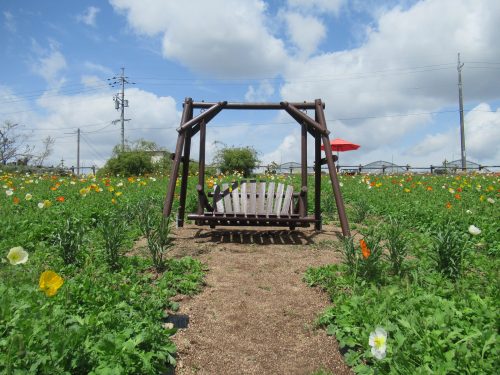
The collage photo frame also serves as an excellent accessory for a commemorative photo here. More likely than not, visitors are taking pictures of each other behind that frame or setting up a tripod with a timer so they can be in there together, but even with no one in the frame, a picture like this featuring only poppies within and without contributes to the surreal effect of this arrangement, like I was taking two photos in a single moment.
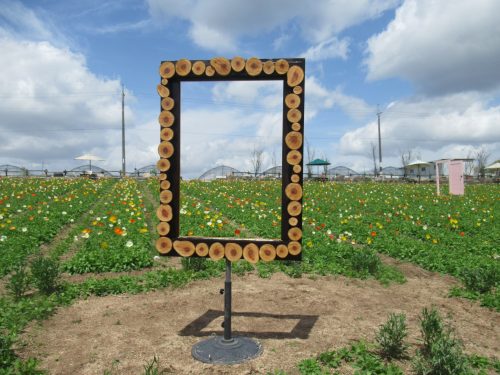
Moment of Joy: Doorway to Good Times
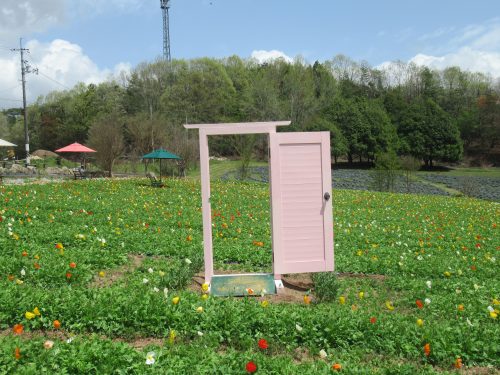
I spent a good chunk of time with every prop in this garden, but probably had the most fun with the pink door. Everyone—myself included—took numerous pictures and videos of themselves walking in and out the door even though there were no indoors to speak of. We all had to plan accordingly to rush in and grab the footage of ourselves and skedaddle to let the next group capture themselves. The poppy fields here may not have been as large as the tulip fields we had just visited, but in terms of fun factor, this second place gave the first a run for its money.
Festival at the Winery

The clock struck high noon when we were en route to Sera Winery for our too-brief-to-be-feasible lunch break. There are always food stands in the courtyard, but since there was apparently some sort of festival going on that day, there were additional vendors who set up shop outside the front entrance of the winery. I am tempted to try so many things here every time I drop by, but I learned my lesson from the previous two tours and actually packed my lunch this time. Those pepperoni pizzas I bought from the Marine Corps Air Station Iwakuni the day before came in handy this afternoon as I sat down at one of the patio tables and immediately dug in.
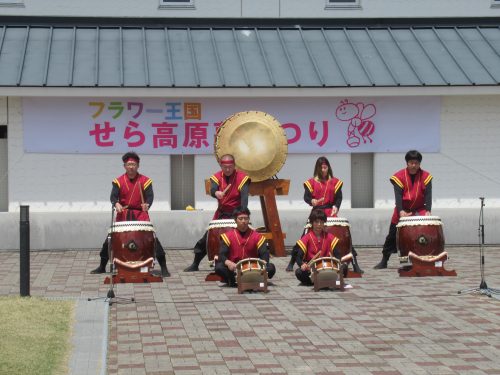
All the while, a taiko troupe was performing in the courtyard, and attracted quite the crowd to boot. Under normal circumstances, our time at the Sera Winery would be the quietest, most boring part of the tour, but I was pleased to know that the opposite would be true today. By the time I finished with my pizza, I was running late for the shuttle bus, but the driver was patiently waiting outside the vehicle for stragglers like me; I guess they don’t lightheartedly leave anyone behind (within reason) after all.
Planting the Dream
The last garden the bus would take us to was 花夢の里, which can be transliterated into English as “Kamu no Sato” or translated as “Flower Dream Village;” either name probably works, but in Japan, you’re more likely to get your point across with transliterations if you don’t speak Japanese. This garden is famous for two types of flowers: moss phlox, whose prime is in April, and nemophila, which are more vivid in May. Kamu no Sato has several vantage points from which to view the moss phlox, and the combined hues of pink and purple created a dreamy, botanical quilt of sorts. There was one field in the lower part of the garden where tourists could stand behind a raised, flower-covered structure and pose for a memorable, possibly humorous photo.
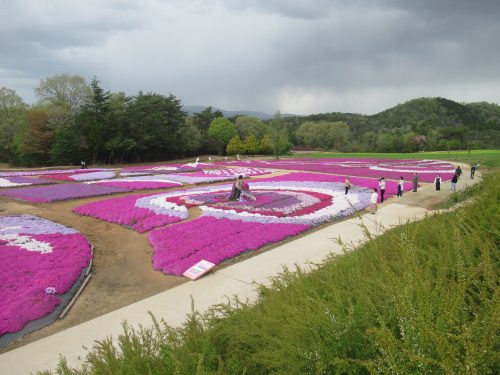
I was so adamant on taking picture-perfect photos of the fields of moss phlox that I ultimately had no time to move on to the nemophila. “No matter,” I thought, as I had seen them just last year, but from the moss phlox, I zoomed in on the bus stop sign in the field to snap one picture sans tourists before rain clouds started rolling in. The timing of those clouds could not have been better though, as the time to head back to the shuttle bus was fast approaching, and I hadn’t even seen the gift shop!

There were no souvenirs inside that considerably piqued my interest, but one thing I wanted to try was the colorful, flower-themed soft serve ice cream sold by the café just outside the store. I couldn’t decide between the blue nemophila flavor and the pink moss phlox flavor, so I did the easy thing and bought both before running for my bus. Never have I ever eaten either flower so I cannot know whether the ice cream flavors were accurate, but I trust that each flavor of soft serve probably tasted like the real flower if one were to remove the milk and sugar.
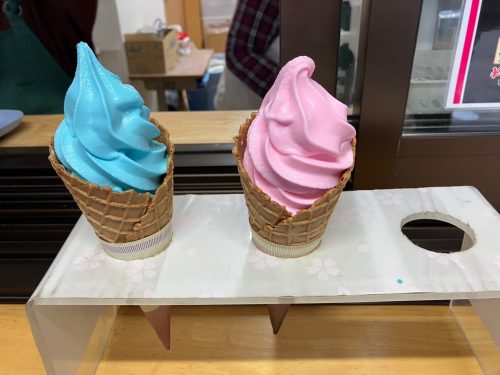
The shuttle bus dropped us off at Roadside Station Sera, from where we would take a highway bus back to Hiroshima City, but not before the driver passed us all a survey card so we could rate our experience for the day. As per my previous experiences, I once again griped that the time for eating at Sera Winery was too short, and personally would not mind reducing time at one or two of the gardens or even making the whole tour start earlier or end later. When I got off at Roadside Station Sera, I was basically just killing time since I didn’t want to buy any Sera souvenirs, but as the rain outside wasn’t so strong I decided to take a stroll. I bought a skewer of that renowned Sera beef from a tent by the parking lot, but the meat was mostly fat and didn’t taste great, so it doesn’t warrant a photo here. Finally, our highway bus came, and it was a sleepy journey back to Hiroshima as I dreamt of a tastier snack that I could buy downtown to sate my appetite.
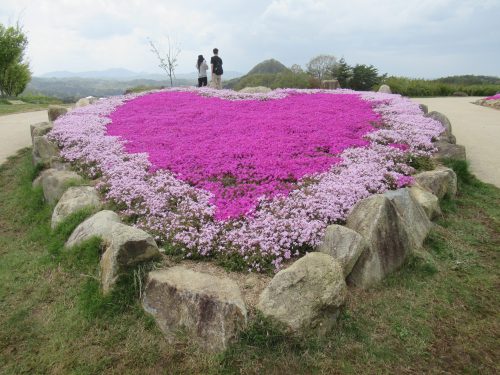
Joining the Sera Hanameguri Kippu bus tour at any time between April and November always puts me on a somewhat rushed schedule, but given the convenience of the busses and the reasonable price of the ticket, I’d say it’s worth it every time. The five periods during which the tour occurs cycle between five different venues, each of which has something unique to discover every tour. Spring isn’t even over and I was already looking forward to joining the same tour during a different period next year to see different flowers growing in the same places. Tourists need never worry about missing Sakura Season, Tulip Time, or any other plant’s peak, because any time they book a Sera Hanameguri Kippu, they are guaranteed a prime time for viewing something in the botanical dreamland that is Sera Town.
Written by the Joy in Hiroshima Team
